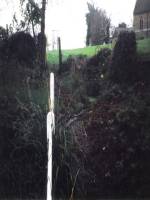Holy Well: OS Grid Reference — TL 559 448
Hadstock lies along the A1052 north of Saffron Walden. Once in the village, a fenced pond will be apparent on the left below the church. Just above the pond is the well that feeds it – yet there seems some confusion regarding the exact location of the site.
Archaeology & History
John Wilson in his Imperial Gazetteer, III (1872) describes it as:
“A well set round with stones, and called St. Botolph’s Well, is in the churchyard.”
However, by the time of An Inventory of the Historical Monuments in Essex, I (1916) it was:
“In the churchyard—a well, known as St. Botolph’s well, now covered.”
Indeed there would be some confusion regarding the exact location of this well. The church guide describes a pump to the west end of the churchyard as the well (but the only pump apparent was that across the road), however I was informed that this well was the one picturesquely situated by the road beneath the church. This is a brick-lined square well whose spring percolates into a pool covered in duckweed. No evidence of any material earlier than Victorian is apparent, suggesting it may date from when the pump was established. A wooden fence has been erected around it to prevent people falling in, but apparently the well itself has been covered.
Folklore
The village has a St. Botolph’s Well although there is no direct link recorded between it and the saint of that name, but local tradition believes that he was interred in this church. This view was supported by the discovery of an empty Saxon grave in the east wall of the South Transept. Greater credence being lent by the fact that this had previously been exhumed, which is in accordance with the knowledge that the relics were removed in 970, and then distributed around East Anglia.
Its waters have had a mixed reputation. Tradition records their ability to cure scrofula. Until recently the well was the important source of drinking water for the village. One tradition suggests that if a ring was dropped into it by a lovelorn girl she would find her true love. This tradition was supported by the finding of two rings recently in the cleaning of the well. Wilson (1970) notes a strange activity was practiced within living memory by the white witch: to keep the water pure, dead cats were placed down the well. Obviously, this was not continued for on one occasion the water was the harbinger of a typhoid outbreak, and forty percent of the population—or 40 people—died (although there is no evidence for either). The contamination was the result of the Rev F. E. Smith using the spring as an outlet for his lavatory. If this was not bad enough, one of his staff was a typhoid carrier! This is also notwithstanding, that it was commonly believed that the spring water drains from the graveyard above it: and hence it has earned the name ‘bone gravy’. Despite all these traditions, this did not deter the locals, who vouched for its goodness. Even when piped water was brought to the village in the 1930s, many locals could not see the point as the well water was good enough.
References:
- Parish, R.B., Holy Wells and Healing Springs of Essex, Pixy Led Publications 2008.
- Royal Commission on Historic Monuments, An Inventory of the Historical Monuments in Essex – volume 1, HMSO: London 1916.
- Wilson, John M., The Imperial Gazetteer of England and Wales – volume 3, A. Fullarton: Edinburgh 1872.
Extracted from the R.B. Parish Holy Wells and healing springs of Essex (2008)
Links:
© R.B. Parish, The Northern Antiquarian
